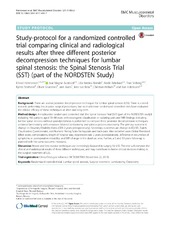| dc.contributor.author | Hermansen, Erland | en_US |
| dc.contributor.author | Austevoll, Ivar Magne | en_US |
| dc.contributor.author | Romild, Ulla Kristina | en_US |
| dc.contributor.author | Rekeland, Frode | en_US |
| dc.contributor.author | Solberg, Tore | en_US |
| dc.contributor.author | Storheim, Kjersti | en_US |
| dc.contributor.author | Grundnes, Oliver | en_US |
| dc.contributor.author | Aaen, Jørn | en_US |
| dc.contributor.author | Brox, Jens Ivar | en_US |
| dc.contributor.author | Hellum, Christian | en_US |
| dc.contributor.author | Indrekvam, Kari | en_US |
| dc.date.accessioned | 2018-03-20T14:29:34Z | |
| dc.date.available | 2018-03-20T14:29:34Z | |
| dc.date.issued | 2017-03-21 | |
| dc.Published | Hermansen E, Austevoll IM, Romild Uk, Rekeland F, Solberg T, Storheim K, Grundnes O, Aaen J, Brox JI, Hellum C, Indrekvam K. Study-protocol for a randomized controlled trial comparing clinical and radiological results after three different posterior decompression techniques for lumbar spinal stenosis: the Spinal Stenosis Trial (SST) (part of the NORDSTEN Study). BMC Musculoskeletal Disorders. 2017;18:121 | eng |
| dc.identifier.issn | 1471-2474 | |
| dc.identifier.uri | https://hdl.handle.net/1956/17536 | |
| dc.description.abstract | Background: There are several posterior decompression techniques for lumbar spinal stenosis (LSS). There is a trend towards performing less invasive surgical procedures, but no multicentre randomized controlled trials have evaluated the relative efficacy of these techniques at short and long-term. Method/design: A multicentre randomized controlled trial [the Spinal Stenosis Trial (SST) (part of the NORDSTEN study)] including 465 patients aged 18–80 years with neurogenic claudication or radiating pain and MRI findings indicating lumbar spinal stenosis without spondylolisthesis is performed to compare three posterior decompression techniques: unilateral laminotomy with crossover, bilateral laminotomy and spinous process osteotomy. The primary outcome is change in Oswestry Disability Index (ODI 2 years postoperatively). Secondary outcomes are change in EQ-5D, Zurich Claudication Questionnaire, and Numeric Rating Scale for leg-pain and back-pain. Also recorded were Global Perceived Effect score, complications, length of hospital stay, reoperation rate 2 years postoperatively, difference in recurrence of symptoms or postoperative instability, and MRI change in the dural sac area. Further, a 5 and 10 years follow-up is planned with the same outcome measures. Discussion: Newer and less invasive techniques are increasingly favoured in surgery for LSS. This trial will compare the clinical and radiological results of three different techniques, and may contribute to better clinical decision making in the surgical treatment of LSS. | en_US |
| dc.language.iso | eng | eng |
| dc.publisher | BioMed Central | eng |
| dc.rights | Attribution CC BY | eng |
| dc.rights.uri | http://creativecommons.org/licenses/by/4.0 | eng |
| dc.subject | Randomized controlled trial | eng |
| dc.subject | Lumbar spinal stenosis | eng |
| dc.subject | Surgical treatment | eng |
| dc.subject | Laminotomy | eng |
| dc.subject | Osteotomy | eng |
| dc.title | Study-protocol for a randomized controlled trial comparing clinical and radiological results after three different posterior decompression techniques for lumbar spinal stenosis: the Spinal Stenosis Trial (SST) (part of the NORDSTEN Study) | en_US |
| dc.type | Peer reviewed | |
| dc.type | Journal article | |
| dc.date.updated | 2018-01-08T13:52:55Z | |
| dc.description.version | publishedVersion | en_US |
| dc.rights.holder | Copyright 2017 The Author(s) | |
| dc.identifier.doi | https://doi.org/10.1186/s12891-017-1491-7 | |
| dc.identifier.cristin | 1486127 | |
| dc.source.journal | BMC Musculoskeletal Disorders | |

